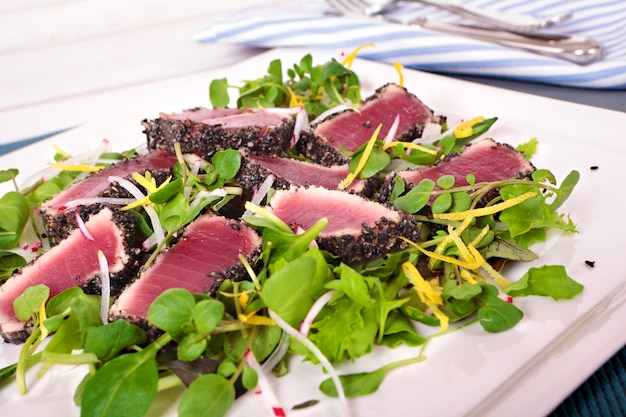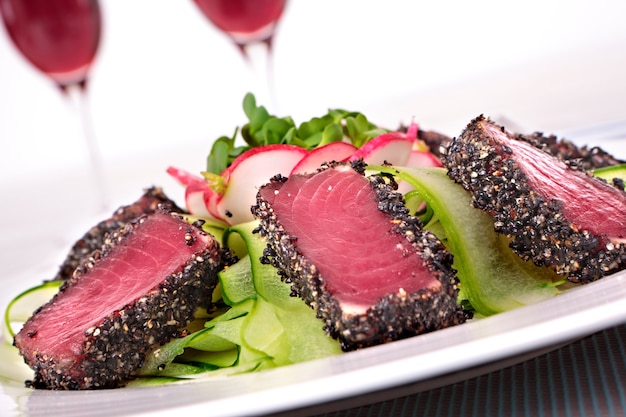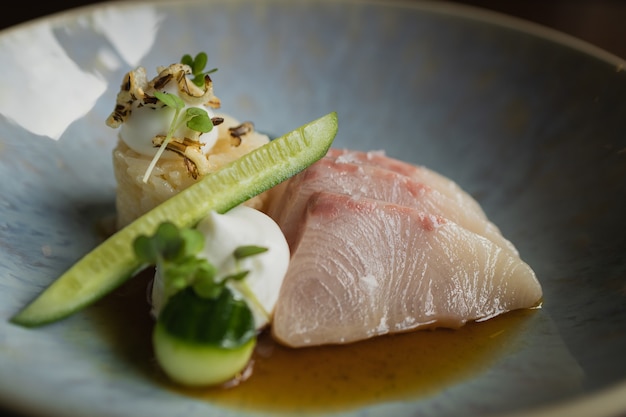ahi tuna. Just the name conjures up images of vibrant, rich red flesh, a delicate buttery flavour, and a melt-in-your-mouth texture. It's a culinary dream, but also a bit intimidating for the uninitiated. Believe me, I've been there. I've had my fair share of dry, overcooked tuna disasters. But after years of experimenting and learning, I've finally cracked the code to perfect ahi tuna. This isn't just a guide to cooking; it's a journey into the heart of this incredible fish, revealing the secrets to unlocking its full potential.
(Part 1) All About Ahi Tuna: A Deeper Dive

Ahi tuna, also known as yellowfin tuna, isn't just any fish. It's a prized catch for its rich flavour, robust texture, and versatility. The key to understanding ahi tuna lies in its unique fat content, which directly impacts both its taste and cooking methods.
The Spectrum of Fat: Understanding Grades
Think of fat content as a spectrum of deliciousness. The higher the fat content, the richer and more decadent the flavour. That's why you'll often see ahi tuna labelled with different grades, reflecting the fat levels. Here's a breakdown to help you navigate the choices:
- Sashimi Grade: This is the crème de la crème, the ultimate tuna experience. It's packed with fat, resulting in a buttery, melt-in-your-mouth texture and a deep, umami flavour. Perfect for sashimi, sushi, and any raw preparation where you want to showcase its rich, luxurious flavour.
- Sushi Grade: A step down from sashimi grade, but still excellent quality. It's slightly less fatty, offering a balance of richness and firmness. Great for sushi, sashimi, and even lightly cooked dishes.
- Regular Grade: The most commonly found grade in supermarkets. It's leaner and more affordable, but it lacks the buttery richness of the higher grades. This grade is best suited for cooking methods that require a longer cooking time, like grilling or pan-searing.
The key is to choose the right grade for the cooking method you have in mind. If you're unsure, a chat with your fishmonger will always be helpful. They can guide you towards the best choice for your specific needs.
Freshness: The Foundation of Flavor
Let's be honest, a perfectly cooked ahi tuna is only as good as the quality of the fish. Ahi tuna is delicate, and it's vital to use the freshest fish possible. So, where do you find this culinary treasure?
The ideal scenario is a reputable fishmonger who sources fresh, high-quality ahi tuna. Here's what to look for:
- Vibrant Red Flesh: The colour should be bright and even, indicating freshness. Avoid any dull or discoloured areas.
- No Fishy Smell: Fresh tuna should have a mild, slightly sweet aroma. A strong fishy smell is a sign of spoilage.
- Firm and Springy Texture: The flesh should be firm to the touch and bounce back slightly when pressed. Avoid any soft or mushy spots.
If you're buying frozen ahi tuna, ensure it's been flash-frozen to preserve quality. Look for "flash-frozen" or "IQF" (Individually Quick Frozen) on the packaging. Defrosting should always be done slowly in the refrigerator overnight. No microwaving!
The freshest tuna is a key ingredient in unlocking the best flavour and texture in your dishes.
(Part 2) Preparing for Culinary Success: It's All in the Details

We've chosen our ahi tuna, now it's time to prep it for the star treatment. These seemingly simple steps are crucial for ensuring a perfectly cooked and flavorful result.
The Art of Patting Dry: Beyond Just Moisture
Patting the tuna dry with paper towels seems like a minor detail, but it's a game-changer. It's not just about removing excess moisture; it's about creating the right conditions for a beautiful, crispy crust.
Here's why it works:
- Enhanced Browning: A dry surface allows for more efficient heat transfer, leading to a deeper, more even crust.
- Crispier Texture: Patting dry helps the tuna develop a delightful crispy exterior, adding a satisfying textural contrast to the soft, tender interior.
- Preserving Flavor: Excess moisture can steam the tuna, diluting its flavor. Patting dry ensures the natural flavour concentrates during cooking.
Seasoning with Purpose: Simple, Elegant, Effective
Ahi tuna is naturally flavorful, but a touch of seasoning can elevate its inherent deliciousness. Keep it simple and let the fish shine.
- Salt and Pepper: The classic combination. It enhances the natural flavour of the tuna, creating a perfectly balanced taste.
- Fresh Herbs: Rosemary, thyme, and oregano add a subtle, fragrant layer to the dish.
- Citrus: A squeeze of lemon or lime juice adds brightness and acidity, complementing the rich, buttery flavour of the tuna.
Remember, the goal is to complement, not overpower, the natural flavor of the fish.
(Part 3) Cooking Methods: A Spectrum of Flavor

Now for the fun part: cooking! Ahi tuna is surprisingly versatile, lending itself to a range of cooking methods. Each method unlocks a unique flavour and texture, allowing you to create dishes that are both delicious and visually stunning.
Pan-Seared Perfection: A Classic with a Twist
Pan-searing is a classic method that yields a beautifully browned exterior and a tender, juicy interior. Here's how to achieve pan-seared perfection:
- Hot Pan: Heat a heavy-bottomed pan over medium-high heat. A hot pan is crucial for achieving that delicious crust.
- Oil Choice: Use a neutral-tasting oil with a high smoke point, like avocado oil or grapeseed oil. Olive oil can work, but it has a lower smoke point and can burn at high temperatures.
- Patience: Once the oil is shimmering, carefully place the tuna steaks in the pan. Don't move them for 2-3 minutes. Let them develop a nice crust before flipping.
- Cook Time: Cook for 2-3 minutes per side for medium-rare, or longer for a more well-done tuna. The key is to keep an eye on it and adjust the cooking time as needed.
- Rest Time: Remove from heat and let the tuna rest for 5 minutes before slicing and serving. This allows the juices to redistribute throughout the steak, ensuring a moist and flavorful result.
Pan-searing is a versatile method that can be used for a variety of dishes, from simple tuna steaks with a squeeze of lemon to more complex dishes featuring a teriyaki glaze.
Sous Vide: Mastering Precision
sous vide cooking is all about precision. It's a method that allows you to control the temperature of the tuna with incredible accuracy, resulting in perfectly cooked, juicy steaks every time. It's like cheating, but in a good way.
- Vacuum Seal: Vacuum-seal the tuna steaks in a food-safe bag, ensuring there's no air inside.
- water bath: Immerse the sealed tuna steaks in a water bath set to 120-125°F (49-52°C) for medium-rare. Use a thermometer to ensure the water temperature remains consistent.
- Cook Time: Cook for 15-20 minutes, depending on the thickness of the steak. Thicker steaks will require a longer cooking time.
- Final Touch: After cooking, quickly sear the tuna for a minute or two on each side to achieve that crispy crust. This adds a beautiful aesthetic and an extra layer of flavor.
Sous vide is a great method for achieving consistent results, especially when cooking for a crowd. It also allows you to cook the tuna in advance, making it perfect for busy weeknights.
Grilling: A Summertime Delight
Grilling ahi tuna is a summertime classic. The smoky flavour adds a delightful depth to the tuna's natural richness, creating a truly unforgettable taste experience.
- Preheat: Preheat your grill to medium-high heat. The grill should be hot enough to create beautiful grill marks without burning the tuna.
- Oil the Grates: Lightly oil the grill grates to prevent the tuna from sticking.
- Cook Time: Place the tuna steaks on the grill and cook for 2-3 minutes per side for medium-rare. Turn the tuna once and only once. Over-turning can lead to a dry and tough texture.
- Rest Time: Remove from the grill and let rest for 5 minutes before serving. This allows the juices to redistribute, ensuring a tender and flavorful result.
Grilling is perfect for a casual outdoor meal, especially when paired with fresh summer salads or grilled vegetables.
(Part 4) Don't Overcook It: The Importance of Doneness
Overcooked tuna is a culinary tragedy. It becomes dry, tough, and loses its delicate flavor. It's a texture that's best avoided, so knowing the right doneness is crucial.
The Doneness Guide: Visual and Temperature Clues
Understanding doneness involves two key elements: internal temperature and visual cues. Here's a breakdown of the most common doneness levels:
| Doneness | Internal Temperature | Visual Cues |
|---|---|---|
| Rare | 110-120°F (43-49°C) | Very red, almost raw in the center |
| Medium-Rare | 120-125°F (49-52°C) | Pink in the center, with some red remaining |
| Medium | 130-140°F (54-60°C) | Mostly pink, with a slight brown edge |
| Medium-Well | 140-150°F (60-66°C) | Mostly brown, with a small pink center |
| Well-Done | 150°F (66°C) and above | Completely brown, with no pink |
For optimal flavor and texture, aim for medium-rare or medium. I personally prefer medium-rare, as it allows the tuna to retain its tender, juicy texture and delicate flavour. But it's a matter of taste.
Using a meat thermometer is a reliable way to ensure accurate doneness, but it's not always necessary. Visual cues are just as important, especially with a fish like ahi tuna.
Colour Clues: Your Visual Guide
- Red: Raw to rare.
- Pink: Medium-rare to medium.
- Brown: Medium-well to well-done.
If you're unsure about the doneness, it's always better to err on the side of undercooked. You can always cook it a bit longer, but you can't uncook it!
(Part 5) Finishing Touches: Elevating the Flavor
Your ahi tuna is cooked to perfection. Now, it's time to add those final touches that transform a good dish into a truly unforgettable experience.
Simple Elegance:
- Citrus Zest: A sprinkle of lemon or lime zest adds a vibrant burst of flavour and a beautiful visual touch.
- Fresh Herbs: A sprinkle of chopped cilantro, basil, or parsley adds a fragrant touch and a refreshing flavour contrast.
- Sesame Seeds: Toasted sesame seeds offer a nutty, umami punch that complements the tuna's richness.
Bold Flavours:
- Spicy Mayo: Mix mayonnaise with sriracha or other hot sauce for a spicy kick. It's a perfect combination for grilled or pan-seared tuna.
- Teriyaki Glaze: Brush the tuna with a sweet and savory teriyaki glaze during the last minute of cooking for a beautiful glaze and an extra layer of flavor.
- Mango Salsa: A vibrant mango salsa adds a tropical twist to ahi tuna, perfect for a summer meal.
These finishing touches are all about adding a personal touch to your dish, reflecting your culinary preferences and creative flair.
(Part 6) Serving Suggestions: From Simple to Spectacular
The beauty of ahi tuna lies in its versatility. It's equally at home in simple, casual dishes and elaborate, sophisticated creations. Here are a few ideas to inspire your culinary adventures.
Ahi Tuna Salad: A Classic for a Reason
Ahi tuna salad is a refreshing, healthy, and absolutely delicious way to showcase this versatile fish. It's simple to make and can be customized with your favourite ingredients.
- Chop: Chop the cooked tuna into cubes.
- Toss: Toss with your favourite salad ingredients, like avocado, cucumber, red onion, cherry tomatoes, and a light vinaigrette.
- Serve: Serve over a bed of mixed greens or on a crusty bread for a satisfying meal.
Tuna Tacos: Casual and Flavorful
Ahi tuna tacos are a casual and crowd-pleasing meal that's perfect for a summer barbecue or a weeknight dinner.
- Grill: Grill tortillas until slightly charred.
- Fill: Fill with your cooked ahi tuna, salsa, avocado, and a squeeze of lime.
- Top: Add toppings like cilantro, red onion, or a dollop of sour cream.
Tuna Sashimi: A Culinary Adventure
For the adventurous foodie, making your own tuna sashimi is a truly rewarding experience. It's all about the quality of the tuna, so choose sashimi-grade tuna for the best flavour and texture.
- Slice: Thinly slice the tuna using a sharp knife.
- Serve: Serve with traditional accompaniments like soy sauce, wasabi, and pickled ginger.
- Garnish: Garnish with a sprig of fresh cilantro or a few sesame seeds.
Tuna Poke Bowls: Customizable and Healthy
Poke bowls are a trendy and customizable meal that's both delicious and healthy. They're perfect for meal prepping, as you can customize each bowl to your liking.
- Base: Choose a base like rice, quinoa, or salad greens.
- Add Tuna: Dice cooked ahi tuna and add it to your base.
- Get Creative: Add toppings like avocado, edamame, cucumber, mango, and your favourite sauces.
These are just a few ideas to get you started. Let your culinary creativity guide you as you explore the endless possibilities with ahi tuna.
(Part 7) Storage and Leftovers: Keeping the Goodness Alive
Sometimes, even with the best intentions, we end up with leftover ahi tuna. It's a shame to waste such a delicious ingredient, so here's how to store it properly and make the most of those leftovers.
Refrigerating Leftovers: Freshness is Key
If you have cooked ahi tuna leftovers, place them in an airtight container and refrigerate for up to 3 days. The key is to keep it airtight to prevent the tuna from drying out or absorbing other flavors in the refrigerator.
Freezing for Future Delights: Planning Ahead
To freeze cooked tuna, wrap it tightly in plastic wrap or foil, then place it in a freezer-safe bag and freeze for up to 3 months. This is a great way to preserve the freshness of your tuna for future meals.
When defrosting frozen tuna, transfer it from the freezer to the refrigerator overnight. Never defrost tuna at room temperature, as this can lead to bacterial growth.
Proper storage ensures your leftovers remain fresh and delicious for days or even months, allowing you to enjoy the taste of ahi tuna long after your initial culinary creation.
(Part 8) FAQs: All Your Tuna Questions Answered
Let's be honest: you've got questions. And I'm here to answer them.
1. Can I use any kind of tuna for this?
While you can use other types of tuna, ahi tuna is the best choice for its rich flavor and melt-in-your-mouth texture. It's worth seeking out. Other types of tuna, like albacore or skipjack, have a different flavor profile and texture.
2. What happens if I overcook the tuna?
Overcooked tuna becomes dry, tough, and loses its delicate flavor. It's not a good experience, so don't overcook it! Aim for medium-rare or medium for the best results.
3. How do I know if tuna is fresh?
Fresh tuna has a bright red color, no fishy smell, and firm, springy texture. If you're unsure, ask your fishmonger for advice. They are experts on seafood and can guide you towards the freshest options.
4. Is it safe to eat raw tuna?
It's generally safe to eat raw tuna as long as it's sushi-grade or sashimi-grade and properly handled. However, it's best to avoid raw fish if you're pregnant, have a weakened immune system, or have any concerns about food safety.
5. What are some good side dishes for ahi tuna?
Simple side dishes like roasted vegetables, steamed rice, or quinoa pair well with ahi tuna. You can also get creative with salads, salsas, or other toppings to enhance the flavour and texture.
So there you have it. My ultimate guide to perfect ahi tuna cooking. It's all about understanding the fish, treating it with respect, and mastering the cooking techniques. With a little bit of practice, you'll be a tuna pro in no time. Now, go forth and create culinary masterpieces!
Everyone is watching

Perfect Rice Every Time: The Ultimate Guide to Cooking Rice
Cooking TipsAs a self-proclaimed foodie, I've always been a bit obsessed with rice. It's the foundation of countless cuisi...

Prime Rib Roast Cooking Time Chart: Per Pound Guide
Cooking TipsPrime rib roast. Just the name conjures images of lavish dinners, crackling fires, and hearty laughter. It’s ...

The Ultimate Guide to Cooking Asparagus: Tips, Techniques, and Recipes
Cooking TipsAsparagus. The mere mention of this spring delicacy conjures up images of vibrant green spears, crisp and burs...

Ultimate Guide to Cooking the Perfect Thanksgiving Turkey
Cooking TipsThanksgiving. Just the word conjures up images of overflowing tables laden with delicious food, the scent of r...

How Long to Bake Potatoes in the Oven (Perfect Every Time)
Cooking TipsBaked potatoes are a staple in my kitchen. They're incredibly versatile, delicious, and surprisingly easy to m...
